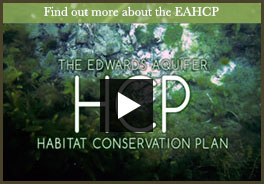Find out Eahcp

The Partners
- Edwards Aquifer Authority
- The City of New Braunfels
- The City of San Marcos
- The City of San Antonio acting by and through its San Antonio Water System Board of Trustees
- Guadalupe-Blanco River Authority
- Texas State University
- Texas Parks and Wildlife Department (TPWD)
- United States Fish and Wildlife Service (USFWS)
Contact Information
- 900 E. Quincy
San Antonio, TX 78215 - P. (210) 222-2204 or 1-800-292-1047
- F. (210) 222-9869
- E-mail: eahcp@edwardsaquifer.org
Janis Bush

Bush is the Director of Environmental Science Academic Programs at the University of Texas at San Antonio (UTSA). She is also Director and founder of the TREE (Teaching and Research in Environmental Ecology) Program which is a program to develop underrepresented students into leaders in natural resources and conservation. She has taught several graduate classes, including Environmental Statistics and Advanced Plant Ecology. Initially, she taught laboratories, including Principles of Biology, Genetics, Microbiology, Physiology, Plant Ecology, Plant Physiology, and Field Biology. Due to student interest, she has developed several new classes, which have subsequently been added to the curriculum. These are Wildlife Biology, Ornithology, and Conservation Biology. She has also taught a special studies topic on experimental design, analysis, and presentation.
The main focus of Dr. Bush’s research is in the area of plant ecology. Specifically, she has two major areas of interest. One area of interest is with grass-woody plant interactions and succession in grazed ecosystems, including arid and semi-arid grasslands, savannas, and shrublands. Of particular interest, are the major biotic and abiotic factors that impact the grass-woody plant interaction, and how these factors influence successional changes, which have occurred and are still occurring in many of these ecosystems. A second area of interest concerns rare, threatened, and potentially endangered species of plants. Over the last several years, Dr. Bush has been studying factors that influence the distribution of a federally threatened species of sunflower, Helianthus paradoxus. Results from experiments with this rare species and its more common relative, H. annuus, are leading to an understanding of why this rare species has such a limited range. She would like to be able to delineate several standard experiments, such as those used in studying this rare species, to use in studying other rare and threatened plant species.